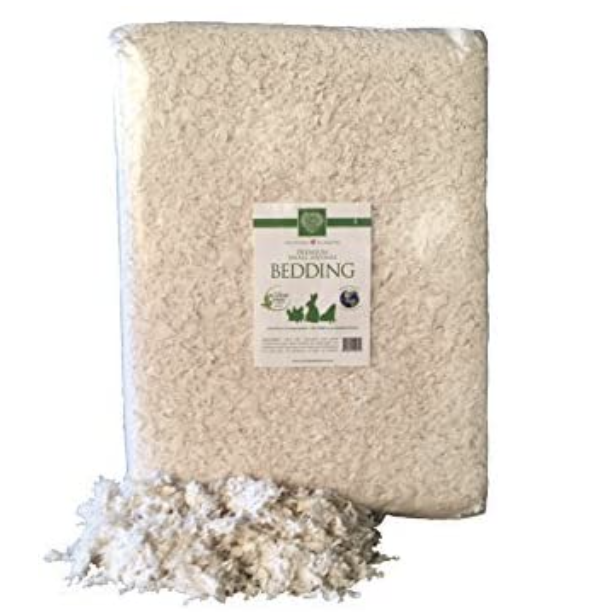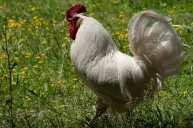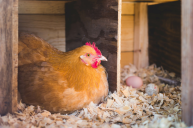Editor's Note: Products featured on Wide Open Pets are independently selected by our editors. However, when you buy something through our links, we may earn a commission.
Whether you are just starting or making a change, chicken coop bedding is one of the biggest decisions in chicken keeping.
We know you want the best bedding in your chickens roost. But there are so many different types of bedding for chicken keepers to use. It can make DIY chicken keeping difficult. Sometimes the popular choice is not the best option for your small coop and breed of chickens. But every chicken owner knows something needs to go on the floor of the coop to mitigate all that chicken waste and reduce the dust. Too much dust in the coop can cause respiratory problems in your flock. Here's a look at the pros and cons of the different types of chicken coop bedding!
Deep Litter Method or Not?
https://www.instagram.com/p/BzaDEqNIybi/
For chicken supplies, visit walmart.com.
One of the first factors in selecting bedding is whether you will use the deep litter method. When the carbon of a chicken coop bedding material and the nitrogen content of chicken manure balance properly, you can use a deep litter method to compost the bedding right in the coop.
Deep litter and composting keep the backyard chicken coop smelling just as fresh as a more frequently cleaned coop, adds warmth from the composting process to the coop in the winter, creates a healthy balance between "good germs" and "bad germs," and provides the chickens interesting material to pick through. It also provides an excellent supplement to your garden and compost pile!
DooKashi eliminates ammonia odors! Keep your chickens healthy and prevent sickness.
However, getting the right bedding material is essential to have the deep litter method work well.
How do you know it's working well?
https://www.instagram.com/p/BzYZiX-nZRO/
The sniff test is the best way to gauge whether your chicken coop bedding is performing as it should. If you can smell even a tiny whiff of ammonia, you need more carbon in the litter. Ammonia will lead to respiratory issues in chickens.
If you have a wooden coop floor, you may need to add a little bit (just a bit!) of moisture to wood shavings to get a good compost going initially. However, a dirt floor is ideal for composting chicken bedding right in the coop.
To repel pests, you can try mixing a bit of diatomaceous earth in with these chicken bedding options, but be cautious as it can be irritating to your lungs and your flock's lungs and can potentially lead to respiratory issues if flung around with abandon.
Wood Shavings
Wood shavings are a really good option for chicken coop bedding. You absolutely need pine wood shavings and not cedar shavings (cedar oils and scents can be toxic to chickens). Go for large flake wood shavings, over fine shavings (too dusty), and don't use sawdust (way too dusty and damp).
We use flake wood shavings from Tractor Supply Co. or the feed store which are sold in a compressed cube. The high carbon content of wood shavings balances out the high nitrogen in chicken manure. Shavings are also easy to clean up with a shovel and easy to loosen and fluff with a pitchfork.
The Drawbacks?
https://www.instagram.com/p/BzY50lhggiv/
For one, wood shavings can potentially give your birds wood splinters. It's not very likely, but it is possible. Second, if you have a large coop, the cost may not be to your liking. Finally, wood shavings are pretty dusty and can contribute to respiratory issues in you or your birds. Birds have very delicate respiratory systems that can get damaged easily. The dust factor is why we do not rate wood shavings to be the best bedding for chickens.
Straw
Straw is an excellent coop bedding option and our pick for the BEST bedding for chickens. It has the benefits of compostable bedding (residual warmth, healthy germ balance, and interesting for chickens to pick through), adds cushioning, and provides a great environment. Straw bedding can also be used in nest boxes.
The Drawbacks?
Straw is not quite as easy to clean as wood shavings, and it can be expensive to buy. You can buy it at the feed store or the hardware supply store in your area. Wet straw could harbor aspergillosis, which is unhealthy for you or your birds (avoid by keeping straw dry and buying good quality straw). Straw is also a good place for mites to breed and grow. Another drawback to using straw is that many farmers tend to use pesticides on their crops which can be harmful to your young chicks and grown flock.
Shredded Paper
Shredded paper is a good choice for chicken coop bedding. It's inexpensive, has a high carbon level, so it should foster beneficial bacteria and compost activity in combination with chicken manure. It also is really useful for baby chicks, especially because you will need to change it out often to keep on top of their droppings. It is easy enough to run through a shredder at home, and It is very absorbent.
Drawbacks?
At one time, inks were toxic, particularly colored inks that may have contained lead and other heavy metals. Most inks are soy-based and non-toxic now, but just to be safe, chicken owners should steer clear of shredding colored paper and definitely steer clear of shredding then using store receipts printed on thermal paper, which contains BPA.
Hay or Grass Clippings
https://www.instagram.com/p/BzVvqOundDB/
Hay or grass clippings are NOT an ideal chicken coop bedding. The main reason is that they are high in nitrogen, so they can't provide a good carbon/nitrogen mix in the coop that fosters beneficial bacteria and composting. An excess of nitrogen is already in the chicken manure. Add in damp grass clippings or hay with even more nitrogen, and you get a stinky coop. Some people have had success with dry grass clippings.
Sand
https://www.instagram.com/p/BzVcsfjHefN/
Sand as a coop bedding seems to have a lot of fans. It's a lot like kitty litter since it is easy to clean with a litter scoop, and looks great, and provides dust bath opportunities anywhere in the coop. However, despite the good reviews, sand is really not the best chicken coop bedding. Sand has some serious drawbacks.
One drawback is that sand does not compost. Healthy bedding will provide a carbon/nitrogen balance and host beneficial bacteria along with your chicken manure. However, because it doesn't compost, sand may be a lot germier (with e. Coli and salmonella-type germs outnumbering beneficial bacteria) than bedding that will compost. In addition, that lack of composting means no residual warmth during the winter.
Another drawback is that sand is a much harder surface and has far less cushioning than other bedding. The third drawback is that chickens are likely to root around and eat poop that's been buried in sand, which isn't healthy and can lead to crop impaction and illness. And finally, sand can be pretty dusty and does not mix well with good respiratory health for you and your chickens.
Pine Needles or Pine Straw
https://www.instagram.com/p/BzTP-vlFsJQ/
Dry pine needles, pine straw, or pine shavings are another good bedding source for the chicken coop. They provide much of the same benefits as straw but at less expense if you have a source on your property. Pine straw is also sold in bales in some parts of the country. Another good option is aspen or hemp bedding too. Shavings are the best for odor control too.
However, pine needles may create a more acidic compost when mixed with chicken feces, but that's great if you like to grow acid-loving plants like blueberries and azaleas.
Dried Leaves
https://www.instagram.com/p/BzPEYJ7hLSg/
Dried leaves can be an excellent chicken coop bedding. Many homesteaders use dried oak leaves, which don't mat together. Leaves are inexpensive and widely available each fall.
The drawbacks?
You can't just buy dried leaves off the shelf, and you do need to be sure they are dry before you put them in your coop to avoid a stinky matted mess.
Wood Chips
https://www.instagram.com/p/BzVxDXbnSBC/
Wood chips are another potentially high carbon source of chicken coop bedding. Anyone with a woodpile who splits and chops their own wood has a supply of wood chips and can use them in the coop. You can also buy bags of wood chips at most garden or home centers or have them delivered by the cubic yard like mulch.
Wood chips (generally chunky) will not have as large a surface area as large flake wood shavings or straw or paper options, so there may be less of an ideal oxygen and good germ mix to aid in composting. Also, watch for potential splinters that might lead to bumblefoot in chickens. However, we have used chips from our woodpile in our coop without any problems.
Key to Success
The key to success in chicken coop bedding is to get fluffy carbon-rich bedding that ideally can compost right in the coop with chicken manure. Straw is our favorite and our pick for the best chicken coop bedding, but in practice, we use large flake wood shavings most of the time due to the cost of straw in our area and for ease of cleaning.
What's your favorite bedding for chickens? Let us know on our Wide Open Pets Facebook page!
This post was originally published on September 17, 2017.








